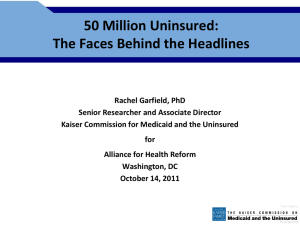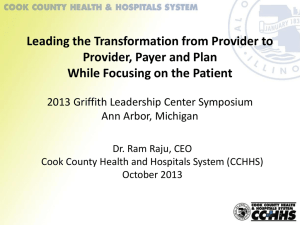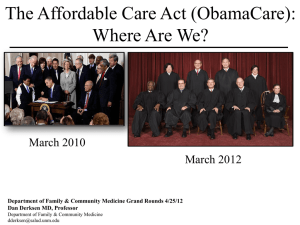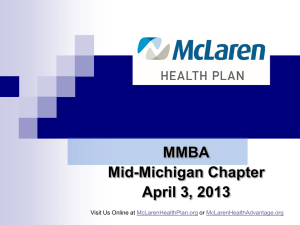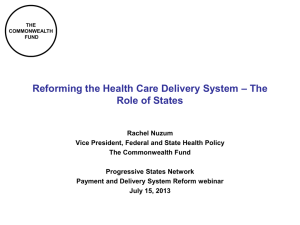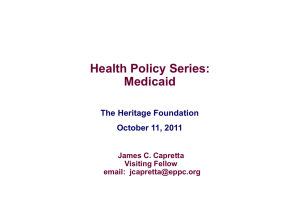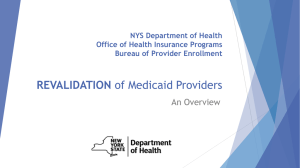Private Non-Group Medicaid* Employer
advertisement
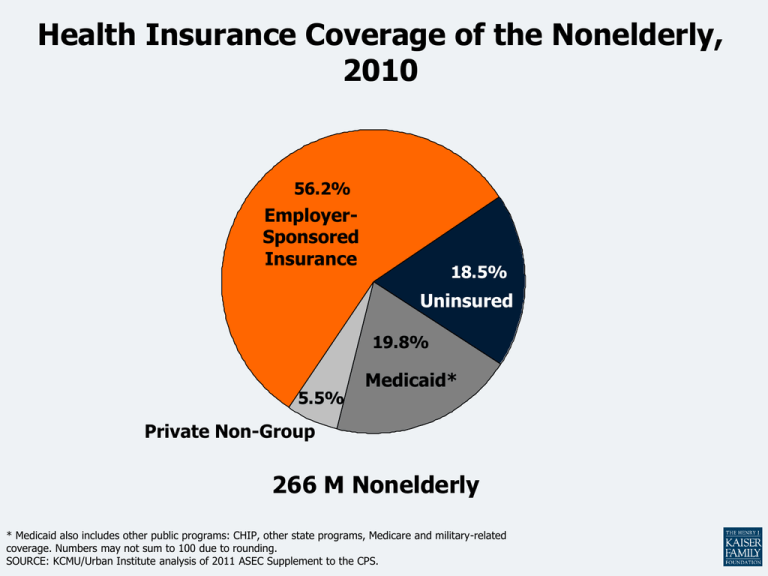
Health Insurance Coverage of the Nonelderly, 2010 56.2% EmployerSponsored Insurance 18.5% Uninsured 19.8% 5.5% Medicaid* Private Non-Group 266 M Nonelderly * Medicaid also includes other public programs: CHIP, other state programs, Medicare and military-related coverage. Numbers may not sum to 100 due to rounding. SOURCE: KCMU/Urban Institute analysis of 2011 ASEC Supplement to the CPS. Medicaid plays a critical role for selected populations Percent with Medicaid coverage: All Nonelderly Individuals Poor Near Poor 43% 26% Families All Children 34% Low-Income Children Low-Income Adults 59% 22% Births (Pregnant Women) 45% Aged & Disabled Medicare Beneficiaries People Living with HIV/AIDS Nursing Home Residents 20% 47% 70% SOURCE: Kaiser Commission on Medicaid and the Uninsured and Urban Institute analysis of ASEC Supplement to the CPS; Birth data from Maternal and Child Health Update: States Increase Eligibility for Children's Health in 2007, National Governors Association, 2008; Medicare data from USDHHS. Medicaid Facilitates Access to Care for Nonelderly Adults Employer/Other Private Medicaid/Other Public Uninsured 53% 30% 10% 10% No Usual Source of Care 26% 12% 10% 7% Postponed Seeking Care Due to Cost 4% Went Without Needed Care Due to Cost In past 12 months. Respondents who said usual source of care was the emergency room were included among those not having a usual source of care. All differences between the uninsured and the two insurance groups are statistically significant (p<0.05). SOURCE: KCMU analysis of 2011 NHIS data. The elderly and disabled account for the majority of Medicaid spending Disabled 15% Elderly 10% Disabled 43% Adults 26% Elderly 23% Children 49% Adults 14% Children 21% Enrollees FY 2009 = 62.6 million Expenditures FY 2009 = $346.5 billion NOTE: Percentages may not sum to 100 due to rounding. SOURCE: KCMU/Urban Institute estimates based on data from FY 2009 MSIS and CMS-64, 2012. MSIS FY 2008 data were used for MA, PA, UT, and WI, but adjusted to 2009 CMS-64. Medicaid spending growth per capita was slower than private health care spending from 2007 to 2010. 5.5% 3.4% 3.4% 3.3% 2.5% 1.1% Medicaid Medicaid services per acute care enrollee per enrollee Medicaid LTC per enrollee 0.9% NHE per capita Private health insurance per enrollee Medical care CPI Note: Acute Care includes payments to managed care plans. Source: Medicaid estimates from Urban Institute analysis of data from the Medicaid Statistical Information System (MSIS), Centers for Medicare and Medicaid Services (CMS) Form 64, and Kaiser Commission and Health Management Associates data, 2011. Private health insurance and GDP data from Centers for Medicare & Medicaid Services Office of the Actuary, National Health Statistics Group, 2011. Medical care CPI from the Bureau of Labor Statistics, Consumer Price Index Detail Report Tables, 2011. GDP per capita Expanding Coverage Under the Affordable Care Act Federal Poverty Level 56% EmployerSponsored Insurance 10% 400%+ 37% 139-399% (Subsidies) 18% Uninsured 20% Medicaid* 54% <139% (Medicaid) 6% Private NonGroup 266 M Nonelderly 49.1 M Uninsured * Medicaid also includes other public programs: CHIP, other state programs, Medicare and military-related coverage. The federal poverty level for a family of three in 2012 is $19,090. Numbers may not add to 100 due to rounding. SOURCE: KCMU/Urban Institute analysis of 2011 ASEC Supplement to the CPS. Uninsured Adults By Income, 2010 <139% FPL (Medicaid) 52% (21.6 M) 139% FPL+ 48% (19.6 M) Total Uninsured Nonelderly Adults= 41.2 Million Adults includes all individuals aged 19-64. The federal poverty level for a family of three in 2010 was $18,210. Percentages may not sum to 100 due to rounding. SOURCE: KCMU/Urban Institute analysis of March 2011 Current Population Survey, Annual Social and Economic Supplement. The Federal Government Will Pay for the Large Majority of Medicaid Coverage Costs in Health Reform Federal 95.4% $443.5 Billion Total: $464.7 billion over 2014-2019 Note: Adults less than 133% FPL under standard participation scenario. SOURCE: Analysis for KCMU by The Urban Institute, May 2010 State: 4.5% $21.1 Billion

